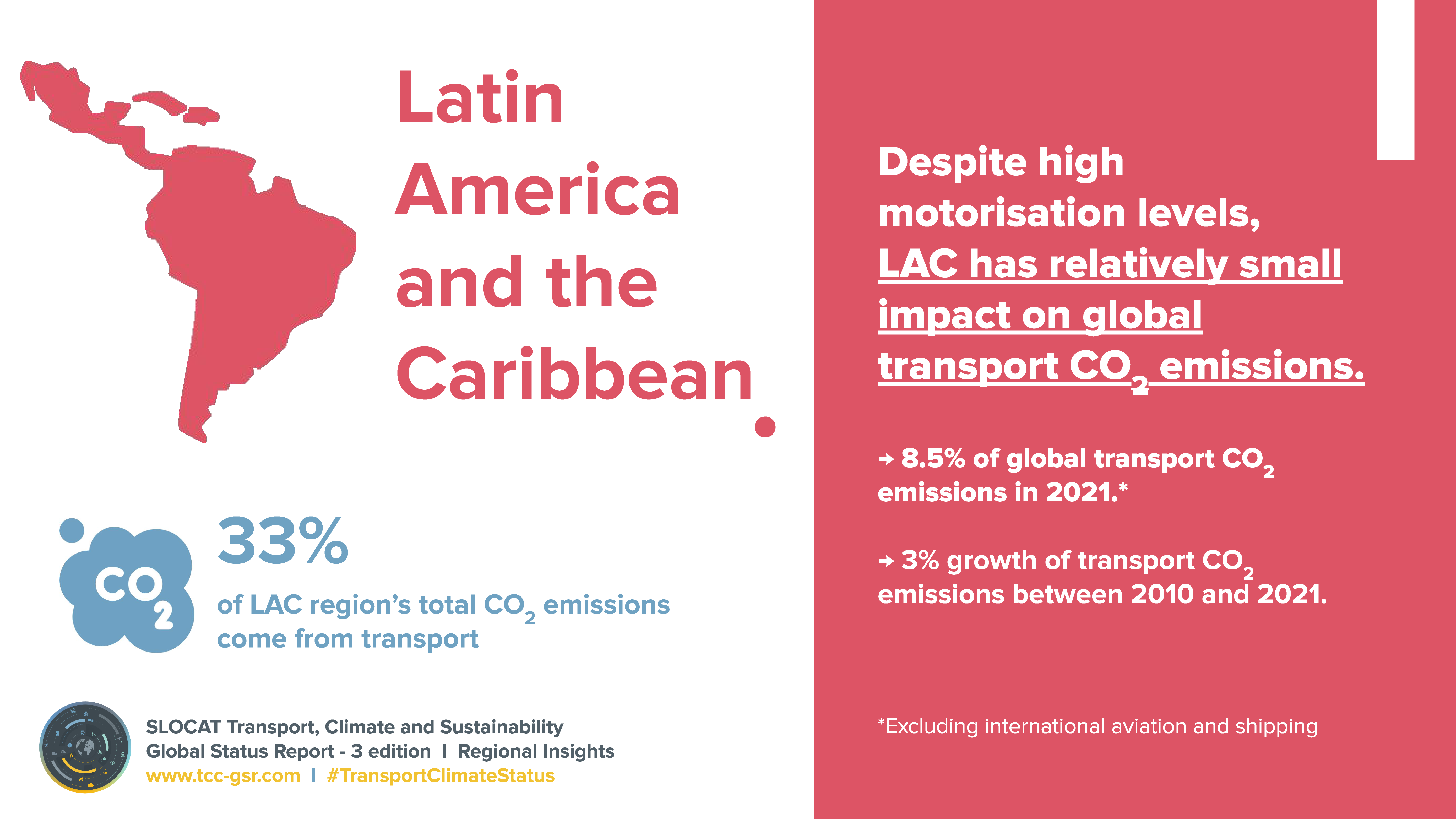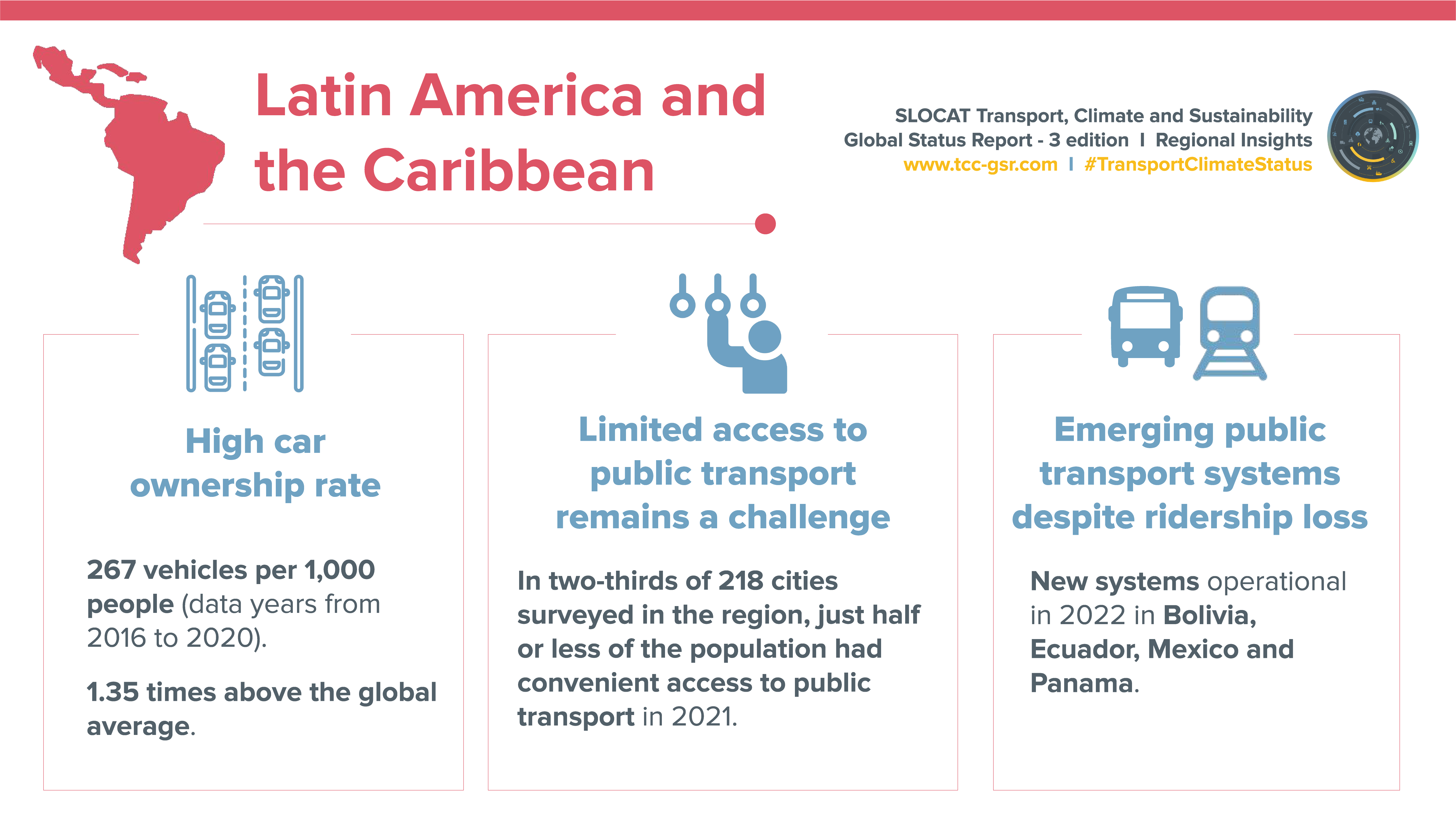-
 Latin America and the Caribbean Regional Overview
Latin America and the Caribbean Regional Overview
Population size
(2022)
Population growth
(2010-2022)
%
Urban population share
(2022)
%
Urban population
growth (2010-2022)
%
GDP per capita
(2021)
GDP growth
(2010-2021)
%
- Key Findings
Demand trends
- From 2016 to 2020, the average motorisation rate (covering four-wheeled motor vehicles) in Latin America and the Caribbean was 267 vehicles per 1,000 people, or 1.35 times higher than the global average of 197 vehicles per 1,000 people. Nearly half of all countries in the region had motorisation rates above the global average during this period.
- Personal use of private cars and motorcycles continued to grow, as people perceived a lower risk of contagion from COVID-19 compared to public transport, and driven by other factors such as convenience, accessibility and safety.
- In two-thirds of 218 cities surveyed in Latin America and the Caribbean, just half or less of the population had convenient access to public transport in 2021. Public transport was heavily impacted by the pandemic and has taken longer to recover in the region than driving and walking.
- Because of the limited supply of adequate public transport, especially in peripheral low-income areas, the majority of public transport trips in the region are served by semi-formal and informal transport, which provides a flexible and demand-responsive service.
- Walking remained a major mode of transport in Latin American cities in 2021 and 2022. Cycling was less prevalent, but countries and cities continued to expand their cycling infrastructure.
-
The uptake of micromobility (bike sharing and e-scooters) has faced challenges in the region, affected by the COVID-19 pandemic, regulatory restrictions and higher-than-expected operational costs. In April 2019 an estimated 73 systems were operating in 31 cities (mostly in Brazil), but by June 2020 these numbers had dwindled to 14 systems in 12 cities. A few new and expanding bike sharing services aim to increase access and promote social inclusion.
- Road transport dominates freight transport in the region. A 2021 study found that in South America trucks account for around 85% of national and 30% of regional freight transport and logistics, and in Central America road transport accounts for nearly 100% of freight transport.
- River and maritime transport represent 95% of international trade in Latin America and the Caribbean, although inland waterways are poorly developed.
- Cycling for first- and last-mile deliveries has increased in the region.
Emission trends
- Carbon dioxide (CO2) emissions from transport in Latin America and the Caribbean grew nearly 11.6% between 2010 and 2019, then fell 15.6% in 2020 as a result of the COVID-19 pandemic. In 2021, the resumption in transport activity led to a 9.1% increase in transport CO2 emissions, although they were still 7.9% below the 2019 level.
- In 2021, transport CO2 emissions in the region contributed around 33% of overall regional CO2 emissions and 8.5% of global transport emissions (excluding international aviation and shipping.
- Transport emissions relative to economic output were higher in Latin America and the Caribbean than in any other region except Africa in 2021, at 1.07 tonnes of CO2 per USD 10,000, and were above the global average of 0.77 tonnes of CO2 per USD 10,000 in 2021.
- Most countries in the region continued to subsidise fossil fuels through methods such as direct subsidies, stabilisation funds, tax reductions and exemptions, and control through state companies, thereby working against decarbonisation of the sector. Efforts to reduce these subsidies remain unsuccessful and have led to street protests and strikes.
- Although Latin America and the Caribbean remains an emerging market for electric cars (battery electric cars and plug-in hybrids), sales rose sharply from around 6,500 units in 2020 to 20,970 units in 2021 and 28,400 units in 2022. However, electric vehicles still made up only small shares of regional (less than 0.1%) and global fleets (2.1%) as of 2021.
- The number of electric public buses in the region grew more than 100% between 2020 and April 2023 (from 1,959 to 4,133 units), operating in 30 cities across 11 countries and accounting for nearly 4.7% of the combined bus fleets of major cities (around 88,364 buses).
Policy developments
- National governments in Latin America and the Caribbean have increasingly recognised the need to support city and local governments in planning and implementing sustainable urban mobility strategies – including through the development of national plans, policies and guidelines.
- Local sustainable urban mobility plans (SUMPS) continued to expand in the region – including in Brazil, Chile, Cuba, Ecuador and Peru – highlighting the role of cities as climate action leaders.
-
As low-emission zones emerge in the region, two cities (Medellín and Rio de Janeiro) were beginning processes for their implementation as of early 2023. Additionally, some countries have developed vehicle efficiency labels to encourage the purchase and use of less-polluting vehicles or to regulate the circulation of certain vehicle types.
- Countries such as Chile and Mexico, and cities such as Bogotá (Colombia), Buenos Aires (Argentina), Lima (Peru) and Rio de Janeiro (Brazil), continued to expand their cycling infrastructure, boosted by measures taken during the pandemic.
- Strategic plans, financial incentives and regulatory elements have emerged to promote the electrification of road transport, many to facilitate the acquisition or operation of electric vehicles. Countries and cities in the region have set targets to electrify vehicle fleets, although electric cars still made up less than 0.1% of the total vehicle stock as of 2021. Electrified public transport modes that began operations included buses, a cable car, light rail systems and tuk-tuks.
- After economic and political delays reinforced by the pandemic, and despite ridership losses, public transport systems expanded in 2022 and 2023, including in Ecuador, Mexico and Panama. Existing metro systems added new lines, and new public transport systems began operations, including bus rapid transit, metro, cable car and light rail systems.
- Argentina, Brazil, Chile and Mexico all have programmes to improve the energy efficiency of freight transport and reduce its emissions, with a focus on innovative technologies and cutting fuel use.
- As of the end of 2022, more than 90% of Latin American and Caribbean countries had submitted a second-generation Nationally Determined Contribution (NDC) towards reducing emissions under the Paris Agreement. However, only 20% of countries had submitted Long-Term Strategies.
Author: Agustina Krapp, SLOCAT Secretariat
Contributors: Carolina Chantrill, Asociación Sustentar; Arturo Steinvorth, Center for Urban Sustainability; Lina Quiñones, Despacio





